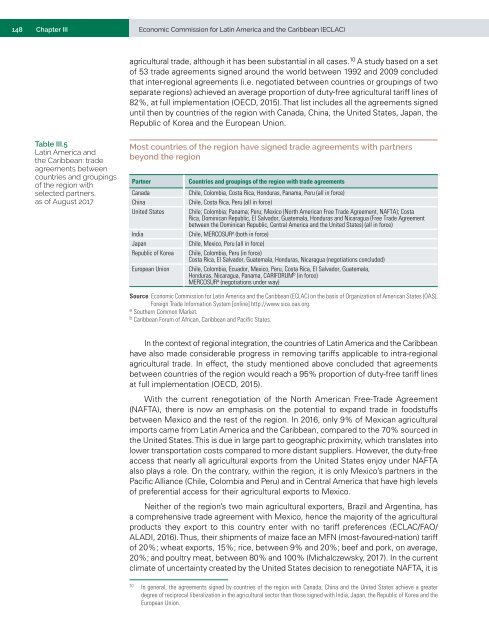International Trade Outlook for Latin America and the Caribbean: Recovery in an uncertain context
This first edition of International Trade Outlook for Latin America and the Caribbean, which is the continuation of Latin America and the Caribbean in the World Economy with a new title, covers 2017 and contains three chapters. The first chapter describes the current international context and the recovery of trade in the region. Chapter II reviews the region’s performance in global trade in services in general and in modern services in particular, since 2005. Chapter III provides an overview of Latin America and the Caribbean’s share of the world agricultural trade since 2000 and offers some policy recommendations for increasing the sector’s contribution to regional development.
This first edition of International Trade Outlook for Latin America and the Caribbean, which is the continuation of Latin America and the Caribbean in the World Economy with a new title, covers 2017 and contains three chapters. The first chapter describes the current international context and the recovery of trade in the region. Chapter II reviews the region’s performance in global trade in services in general and in modern services in particular, since 2005. Chapter III provides an overview of Latin America and the Caribbean’s share of the world agricultural trade since 2000 and offers some policy recommendations for increasing the sector’s contribution to regional development.
Create successful ePaper yourself
Turn your PDF publications into a flip-book with our unique Google optimized e-Paper software.
148 Chapter III Economic Commission <strong>for</strong> <strong>Lat<strong>in</strong></strong> <strong>America</strong> <strong><strong>an</strong>d</strong> <strong>the</strong> <strong>Caribbe<strong>an</strong></strong> (ECLAC)<br />
agricultural trade, although it has been subst<strong>an</strong>tial <strong>in</strong> all cases. 10 A study based on a set<br />
of 53 trade agreements signed around <strong>the</strong> world between 1992 <strong><strong>an</strong>d</strong> 2009 concluded<br />
that <strong>in</strong>ter-regional agreements (i.e. negotiated between countries or group<strong>in</strong>gs of two<br />
separate regions) achieved <strong>an</strong> average proportion of duty-free agricultural tariff l<strong>in</strong>es of<br />
82%, at full implementation (OECD, 2015). That list <strong>in</strong>cludes all <strong>the</strong> agreements signed<br />
until <strong>the</strong>n by countries of <strong>the</strong> region with C<strong>an</strong>ada, Ch<strong>in</strong>a, <strong>the</strong> United States, Jap<strong>an</strong>, <strong>the</strong><br />
Republic of Korea <strong><strong>an</strong>d</strong> <strong>the</strong> Europe<strong>an</strong> Union.<br />
Table III.5<br />
<strong>Lat<strong>in</strong></strong> <strong>America</strong> <strong><strong>an</strong>d</strong><br />
<strong>the</strong> <strong>Caribbe<strong>an</strong></strong>: trade<br />
agreements between<br />
countries <strong><strong>an</strong>d</strong> group<strong>in</strong>gs<br />
of <strong>the</strong> region with<br />
selected partners,<br />
as of August 2017<br />
Most countries of <strong>the</strong> region have signed trade agreements with partners<br />
beyond <strong>the</strong> region<br />
Partner<br />
C<strong>an</strong>ada<br />
Ch<strong>in</strong>a<br />
United States<br />
India<br />
Jap<strong>an</strong><br />
Republic of Korea<br />
Europe<strong>an</strong> Union<br />
Countries <strong><strong>an</strong>d</strong> group<strong>in</strong>gs of <strong>the</strong> region with trade agreements<br />
Chile, Colombia, Costa Rica, Honduras, P<strong>an</strong>ama, Peru (all <strong>in</strong> <strong>for</strong>ce)<br />
Chile, Costa Rica, Peru (all <strong>in</strong> <strong>for</strong>ce)<br />
Chile; Colombia; P<strong>an</strong>ama; Peru; Mexico (North <strong>America</strong>n Free <strong>Trade</strong> Agreement, NAFTA); Costa<br />
Rica, Dom<strong>in</strong>ic<strong>an</strong> Republic, El Salvador, Guatemala, Honduras <strong><strong>an</strong>d</strong> Nicaragua (Free <strong>Trade</strong> Agreement<br />
between <strong>the</strong> Dom<strong>in</strong>ic<strong>an</strong> Republic, Central <strong>America</strong> <strong><strong>an</strong>d</strong> <strong>the</strong> United States) (all <strong>in</strong> <strong>for</strong>ce)<br />
Chile, MERCOSUR a (both <strong>in</strong> <strong>for</strong>ce)<br />
Chile, Mexico, Peru (all <strong>in</strong> <strong>for</strong>ce)<br />
Chile, Colombia, Peru (<strong>in</strong> <strong>for</strong>ce)<br />
Costa Rica, El Salvador, Guatemala, Honduras, Nicaragua (negotiations concluded)<br />
Chile, Colombia, Ecuador, Mexico, Peru, Costa Rica, El Salvador, Guatemala,<br />
Honduras, Nicaragua, P<strong>an</strong>ama, CARIFORUM b (<strong>in</strong> <strong>for</strong>ce)<br />
MERCOSUR a (negotiations under way)<br />
Source: Economic Commission <strong>for</strong> <strong>Lat<strong>in</strong></strong> <strong>America</strong> <strong><strong>an</strong>d</strong> <strong>the</strong> <strong>Caribbe<strong>an</strong></strong> (ECLAC) on <strong>the</strong> basis of Org<strong>an</strong>ization of <strong>America</strong>n States (OAS),<br />
Foreign <strong>Trade</strong> In<strong>for</strong>mation System [onl<strong>in</strong>e] http://www.sice.oas.org.<br />
a<br />
Sou<strong>the</strong>rn Common Market.<br />
b<br />
<strong>Caribbe<strong>an</strong></strong> Forum of Afric<strong>an</strong>, <strong>Caribbe<strong>an</strong></strong> <strong><strong>an</strong>d</strong> Pacific States.<br />
In <strong>the</strong> <strong>context</strong> of regional <strong>in</strong>tegration, <strong>the</strong> countries of <strong>Lat<strong>in</strong></strong> <strong>America</strong> <strong><strong>an</strong>d</strong> <strong>the</strong> <strong>Caribbe<strong>an</strong></strong><br />
have also made considerable progress <strong>in</strong> remov<strong>in</strong>g tariffs applicable to <strong>in</strong>tra-regional<br />
agricultural trade. In effect, <strong>the</strong> study mentioned above concluded that agreements<br />
between countries of <strong>the</strong> region would reach a 95% proportion of duty-free tariff l<strong>in</strong>es<br />
at full implementation (OECD, 2015).<br />
With <strong>the</strong> current renegotiation of <strong>the</strong> North <strong>America</strong>n Free-<strong>Trade</strong> Agreement<br />
(NAFTA), <strong>the</strong>re is now <strong>an</strong> emphasis on <strong>the</strong> potential to exp<strong><strong>an</strong>d</strong> trade <strong>in</strong> foodstuffs<br />
between Mexico <strong><strong>an</strong>d</strong> <strong>the</strong> rest of <strong>the</strong> region. In 2016, only 9% of Mexic<strong>an</strong> agricultural<br />
imports came from <strong>Lat<strong>in</strong></strong> <strong>America</strong> <strong><strong>an</strong>d</strong> <strong>the</strong> <strong>Caribbe<strong>an</strong></strong>, compared to <strong>the</strong> 70% sourced <strong>in</strong><br />
<strong>the</strong> United States. This is due <strong>in</strong> large part to geographic proximity, which tr<strong>an</strong>slates <strong>in</strong>to<br />
lower tr<strong>an</strong>sportation costs compared to more dist<strong>an</strong>t suppliers. However, <strong>the</strong> duty-free<br />
access that nearly all agricultural exports from <strong>the</strong> United States enjoy under NAFTA<br />
also plays a role. On <strong>the</strong> contrary, with<strong>in</strong> <strong>the</strong> region, it is only Mexico’s partners <strong>in</strong> <strong>the</strong><br />
Pacific Alli<strong>an</strong>ce (Chile, Colombia <strong><strong>an</strong>d</strong> Peru) <strong><strong>an</strong>d</strong> <strong>in</strong> Central <strong>America</strong> that have high levels<br />
of preferential access <strong>for</strong> <strong>the</strong>ir agricultural exports to Mexico.<br />
Nei<strong>the</strong>r of <strong>the</strong> region’s two ma<strong>in</strong> agricultural exporters, Brazil <strong><strong>an</strong>d</strong> Argent<strong>in</strong>a, has<br />
a comprehensive trade agreement with Mexico, hence <strong>the</strong> majority of <strong>the</strong> agricultural<br />
products <strong>the</strong>y export to this country enter with no tariff preferences (ECLAC/FAO/<br />
ALADI, 2016). Thus, <strong>the</strong>ir shipments of maize face <strong>an</strong> MFN (most-favoured-nation) tariff<br />
of 20%; wheat exports, 15%; rice, between 9% <strong><strong>an</strong>d</strong> 20%; beef <strong><strong>an</strong>d</strong> pork, on average,<br />
20%; <strong><strong>an</strong>d</strong> poultry meat, between 80% <strong><strong>an</strong>d</strong> 100% (Michalczewsky, 2017). In <strong>the</strong> current<br />
climate of uncerta<strong>in</strong>ty created by <strong>the</strong> United States decision to renegotiate NAFTA, it is<br />
10<br />
In general, <strong>the</strong> agreements signed by countries of <strong>the</strong> region with C<strong>an</strong>ada, Ch<strong>in</strong>a <strong><strong>an</strong>d</strong> <strong>the</strong> United States achieve a greater<br />
degree of reciprocal liberalization <strong>in</strong> <strong>the</strong> agricultural sector th<strong>an</strong> those signed with India, Jap<strong>an</strong>, <strong>the</strong> Republic of Korea <strong><strong>an</strong>d</strong> <strong>the</strong><br />
Europe<strong>an</strong> Union.


















